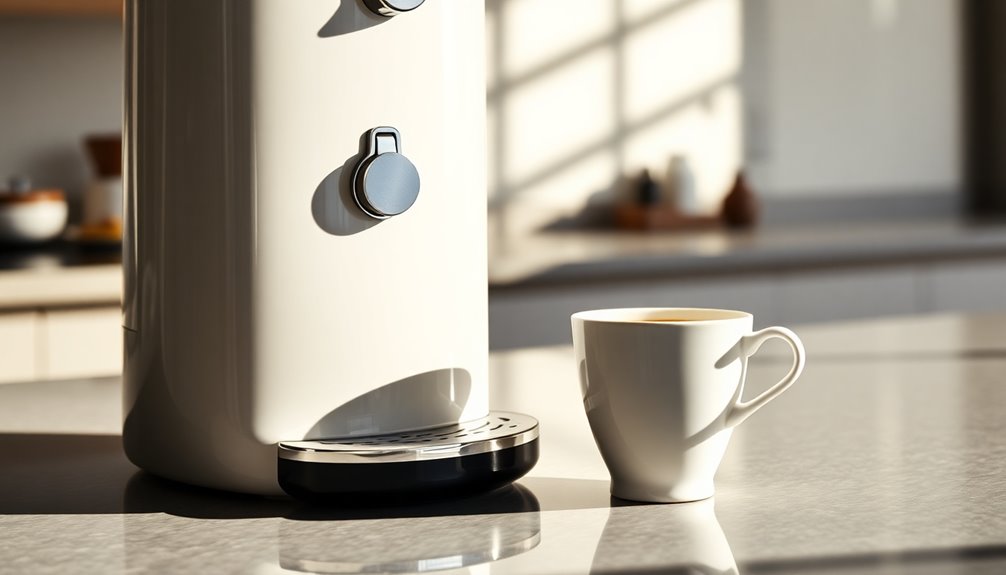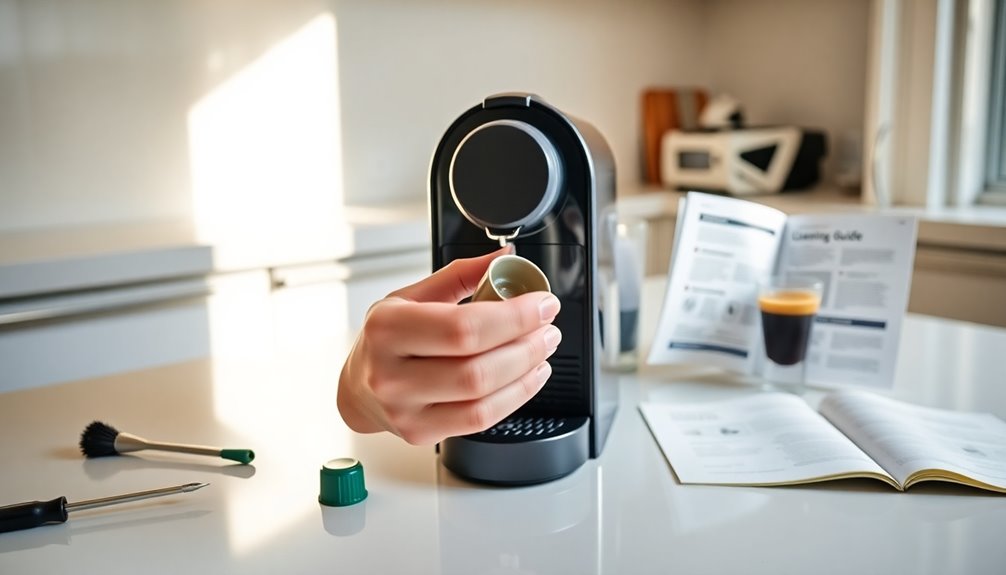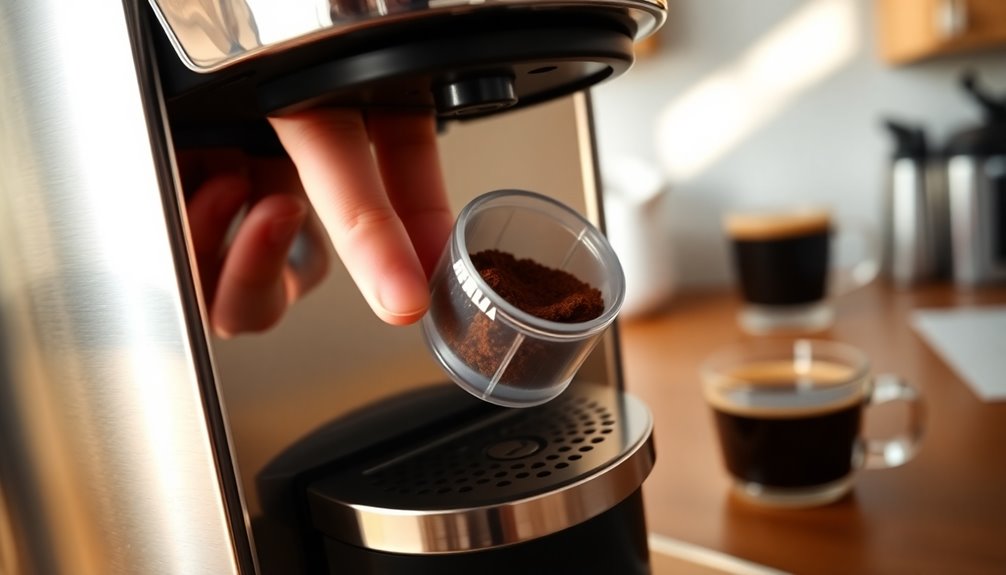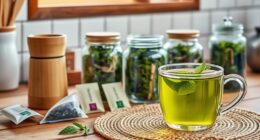Moka pots are your go-to for brewing rich, espresso-like coffee right at home. With a simple design and durable materials like aluminum or stainless steel, they're easy to use and maintain. You'll enjoy the robust flavor that comes from the pressurized brewing process, making each cup bold and satisfying. Opt for models with ergonomic handles for safer pouring, and follow best practices for cleaning to keep your pot in top shape. If you're looking for specific recommendations or want to explore the various options available, you'll find plenty of helpful insights ahead.
Key Takeaways
- Moka pots come in aluminum and stainless steel; stainless steel offers better durability and compatibility with all stovetops.
- Optimal brewing temperature is around 93°C (200°F) with a coffee-to-water ratio of 1:12 for rich flavor.
- Look for ergonomic handles and reliable sealing mechanisms to ensure safety and ease of use during brewing.
- Regular cleaning and maintenance are essential; rinse after use and deep clean every six months to prevent limescale buildup.
- Moka pots produce strong, bold coffee with a simple design, making them an economical choice compared to espresso machines.
Understanding Moka Pot Components

The Moka pot, a beloved brewing device, consists of several key components that work together to create rich coffee.
You'll find three main chambers: the bottom water chamber, the middle coffee ground chamber, and the top coffee collection chamber. These chambers connect via a funnel and tube, allowing steam pressure to push water through the coffee grounds. Spare parts are essential for maintaining the moka pot's functionality, including replacement components that enhance its durability.
The bottom chamber features a water line or safety valve, preventing overheating during brewing. Gaskets are essential, ensuring a tight seal to maintain pressure.
Handles, made from various materials, enhance safety and ergonomics while pouring. Finally, the funnel and filter screens hold the coffee grounds and play a significant role in achieving that perfect brew.
Understanding these components will elevate your coffee-making experience.
Choosing Materials and Construction
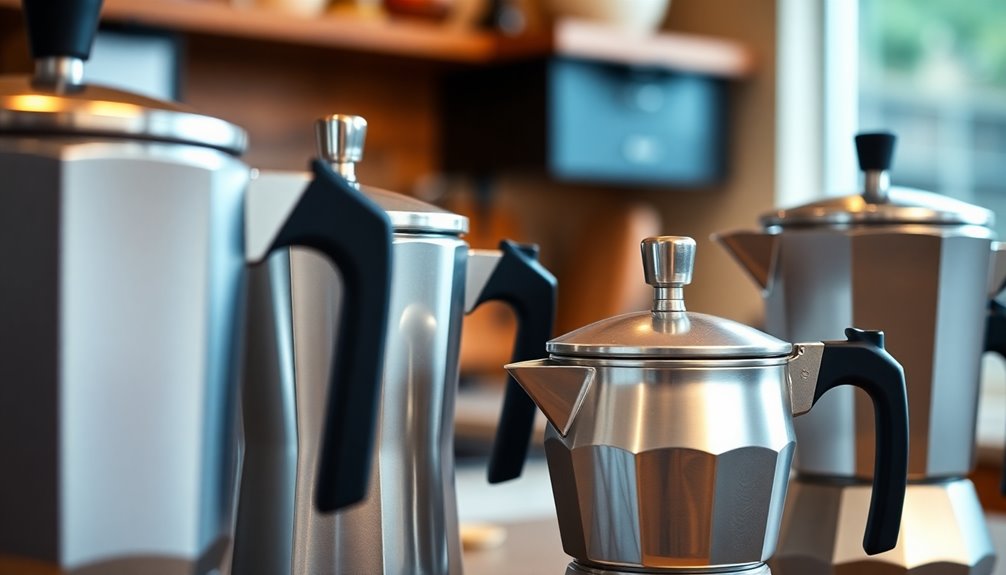
When selecting a Moka pot, the materials and construction play a significant role in your brewing experience.
Aluminum pots are lightweight, heat up quickly, and are generally more affordable, but keep in mind they're not compatible with induction stoves.
On the other hand, stainless steel options offer greater durability and versatility, working on all stovetops and maintaining heat better for faster brewing. Additionally, stainless steel models are preferred for health concerns since they do not react with acidic coffee.
Look for a reliable sealing mechanism with a rubber gasket and safety valve to prevent over-pressurization.
Consider ergonomic handles for comfort and stability, especially on larger burners.
For ease of maintenance, stainless steel is easier to clean and lasts longer, making it a solid choice if you want something that stands the test of time.
Brewing Techniques for Flavor
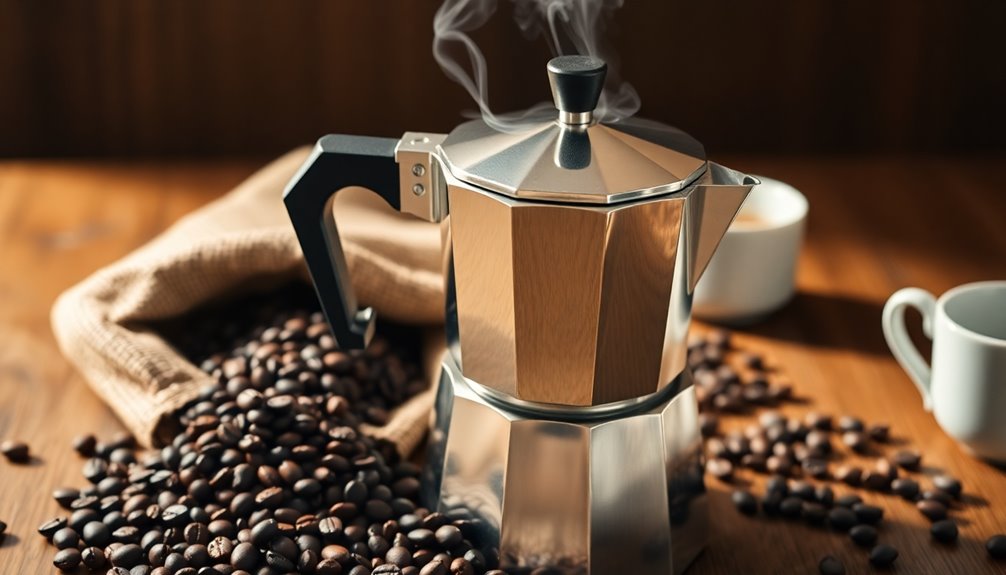
To brew a rich and flavorful coffee with a Moka pot, it's crucial to pay attention to temperature, coffee-to-water ratios, and grind size. Aim for a brewing temperature around 93°C (200°F) by using low to medium heat. This prevents burning your coffee, which can occur with high heat. Additionally, employing effective filtration methods enhances the overall flavor quality of the final cup.
For best flavor, maintain a coffee-to-water ratio of 1:12; for example, use 22g of coffee with 264g of water. Always fill the water reservoir just below the pressure release valve and preheat water to around 99°C.
Opt for a fine grind, avoiding espresso grind sizes to prevent bitterness. Finally, monitor the brewing process and serve immediately to enjoy the best flavor and temperature.
Advantages of Moka Pots

Moka pots offer a unique blend of advantages that make them a popular choice for coffee lovers. Their compact size and portability mean you can brew your favorite coffee anywhere. Built to last, these durable pots resist impacts and work on all stovetops, including induction hobs. Economically, they save you space and money compared to espresso machines, with affordable options available. Plus, the simple design means low maintenance costs. When it comes to coffee quality, Moka pots deliver a strong, bold flavor enriched with coffee oils. Additionally, the Moka pot operates at 1.5-2 bars of pressure, which contributes to its ability to create rich coffee. They're easy to use and provide a hands-on brewing experience, allowing you to control the process. With quick brewing times and consistent results, you'll love every cup you make. Furthermore, the popularity of Moka pots has grown alongside the rise of coffee culture, reflecting a broader trend in how people appreciate their brews.
Cleaning and Maintenance Tips

Keeping your Moka pot in top shape guarantees you'll enjoy rich, flavorful coffee for years to come. Rinse it under hot water after each use, disassembling the components for a thorough clean. Use a soft sponge to wipe them down, and a soft-bristle toothbrush for hard-to-reach areas. Avoid soaps and abrasive materials that can damage the pot. Regular maintenance, including routine cleaning, is crucial for optimal performance.
Deep clean every six months by soaking parts in a vinegar-water solution or boiling them to remove limescale. After cleaning, dry each piece completely to prevent moisture buildup. Always store your Moka pot disassembled to keep it dry. Finally, use filtered water to reduce limescale and improve taste, ensuring a perfect brew every time.
Compatibility and Capacity Considerations

How do you choose the right Moka pot for your kitchen?
First, consider compatibility with your heat source. If you have an induction stovetop, opt for stainless steel models like the Bialetti Venus, as they're made from ferrous materials. Gas and electric stovetops work well with aluminum pots, but avoid aluminum for induction.
Next, think about capacity. A standard Moka pot "cup" is about 2 ounces, so choose a size based on your daily consumption. For one strong coffee, a 3-cup pot is ideal, while a 6-cup pot suits small gatherings. The 3-cup Moka Pot can hold approximately 50cc of water and is often preferred for its ability to produce a richer flavor profile.
Larger pots can take longer to brew, so balance size with brewing efficiency to enhance your coffee experience without waste.
Top Moka Pot Recommendations

When it comes to selecting the right Moka pot for your brewing needs, you have plenty of excellent options to contemplate.
The Bialetti Moka Express is a classic choice, known for its iconic design and consistently good coffee. Spare parts are easy to find, which adds to its usability over time.
If you're after aesthetics, the Alessi 9090 offers beautiful craftsmanship, though it comes with a higher price tag.
For durability, consider the Grosche Milano, which features a heat-resistant handle and silicone gasket.
If you need something induction-compatible, the LuxHaus Stovetop Espresso Maker is both durable and dishwasher safe.
If portability is key, the Bialetti Musa makes strong coffee and is great for camping.
Each of these pots has unique features to fit various preferences and needs.
Frequently Asked Questions
Can I Use Pre-Ground Coffee in a Moka Pot?
Yes, you can use pre-ground coffee in a Moka pot, but make sure it's the right grind size—medium to medium-fine works best.
Avoid fine grinds, as they can clog the filter and lead to a chalky taste. Check the packaging for grind specifications, and if possible, opt for high-quality pre-ground coffee designed for Moka pots.
How Long Does It Take to Brew Coffee in a Moka Pot?
Brewing coffee in a Moka pot typically takes about 2-3 minutes, depending on the size and heat used.
For smaller pots, like a 2-cup, you'll need around 1-1.08 minutes, while larger ones can take 5-7 minutes.
Keep the heat low to medium for a steady brew, and listen for that gurgling sound—it signals that your coffee is ready.
Adjust factors like grind size and water level to optimize your brewing time!
Is a Moka Pot Suitable for Making Espresso-Based Drinks?
Yes, a moka pot's great for making espresso-based drinks.
It brews dark, rich coffee that's similar to espresso, though it won't be as strong due to lower pressure. With the right technique, you can achieve a light crema and a balanced flavor, making it perfect for lattes or cappuccinos.
Plus, its efficient brewing process means you can enjoy your coffee quickly, making it a convenient choice for daily use.
What Is the Difference Between Moka Pot and Traditional Espresso Machines?
When you compare a moka pot to a traditional espresso machine, you’ll notice several key differences. One of the main differences is the brewing method. A moka pot uses steam pressure to force water through coffee grounds, while an espresso machine uses a pump to force hot water through the coffee at high pressure. Additionally, moka pots are typically smaller and more portable than espresso machines. Both devices fall under the category of stovetop espresso techniques, but they achieve the same result in different ways.
Moka pots use lower steam pressure to brew coffee, producing a rich, full-bodied flavor, but it isn't as concentrated as espresso.
Espresso machines operate at much higher pressures, creating intense shots with a layer of crema.
Additionally, moka pots are affordable and portable, while espresso machines can be complex and expensive, designed for a wider variety of drinks.
How Do I Know When My Moka Pot Coffee Is Ready?
To know when your moka pot coffee is ready, pay attention to both visual and auditory cues.
Watch for coffee emerging from the spout and changing to a lighter shade.
Listen for gurgling and bubbling sounds as it brews.
Once you hear a loud gurgle and only steam escapes, it's time to remove it from the heat.
Cooling the base can help stop the extraction and prevent any burnt taste.
Enjoy your brew!
Conclusion
To sum up, using a moka pot can elevate your coffee experience, bringing rich flavors right to your kitchen. By understanding its components, choosing the right materials, and mastering brewing techniques, you'll enjoy a delightful espresso-like beverage. Remember to keep it clean and consider compatibility for the best results. Whether you're a novice or a seasoned coffee lover, selecting one of the top moka pots will surely enhance your morning routine. Happy brewing!



